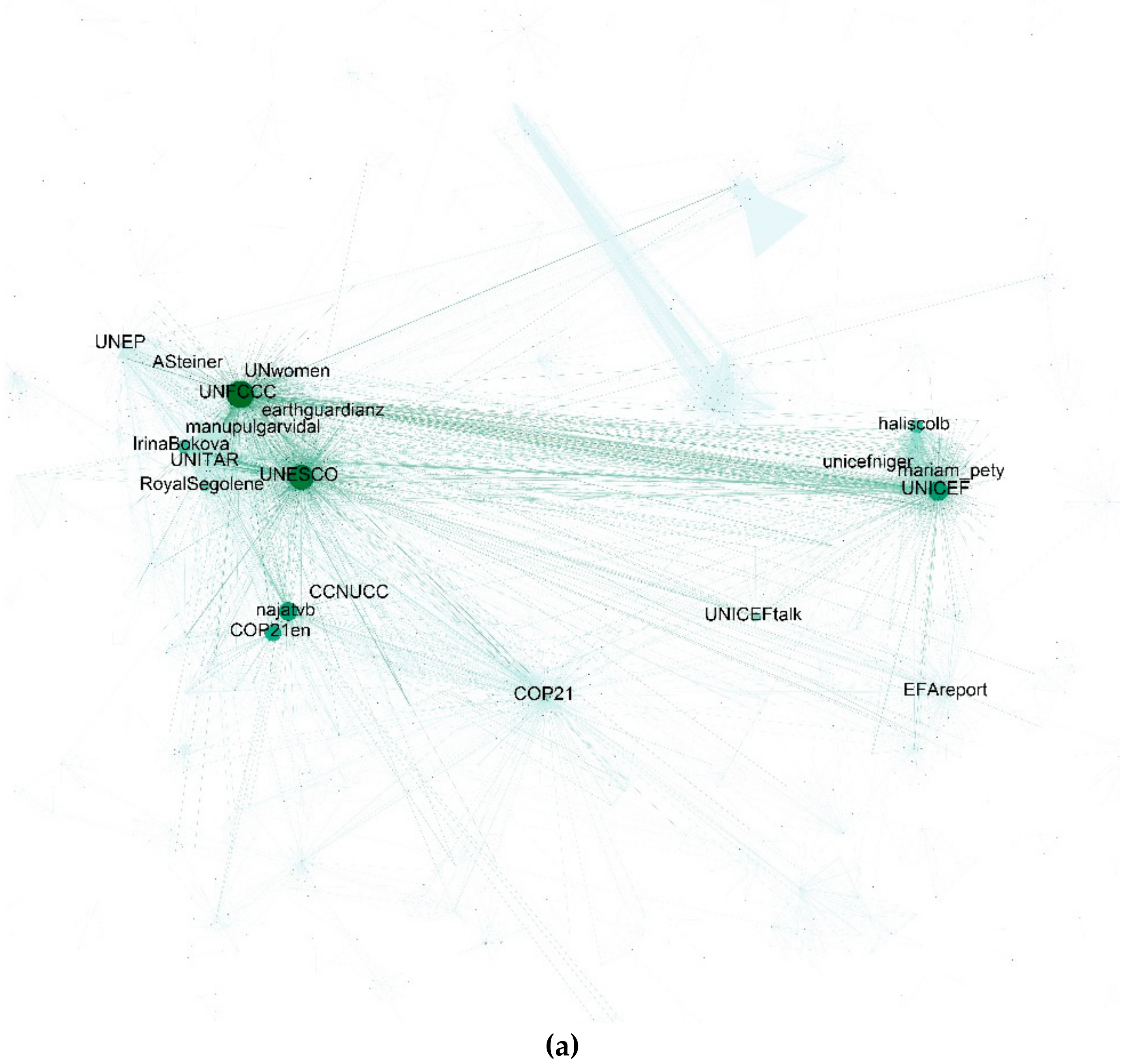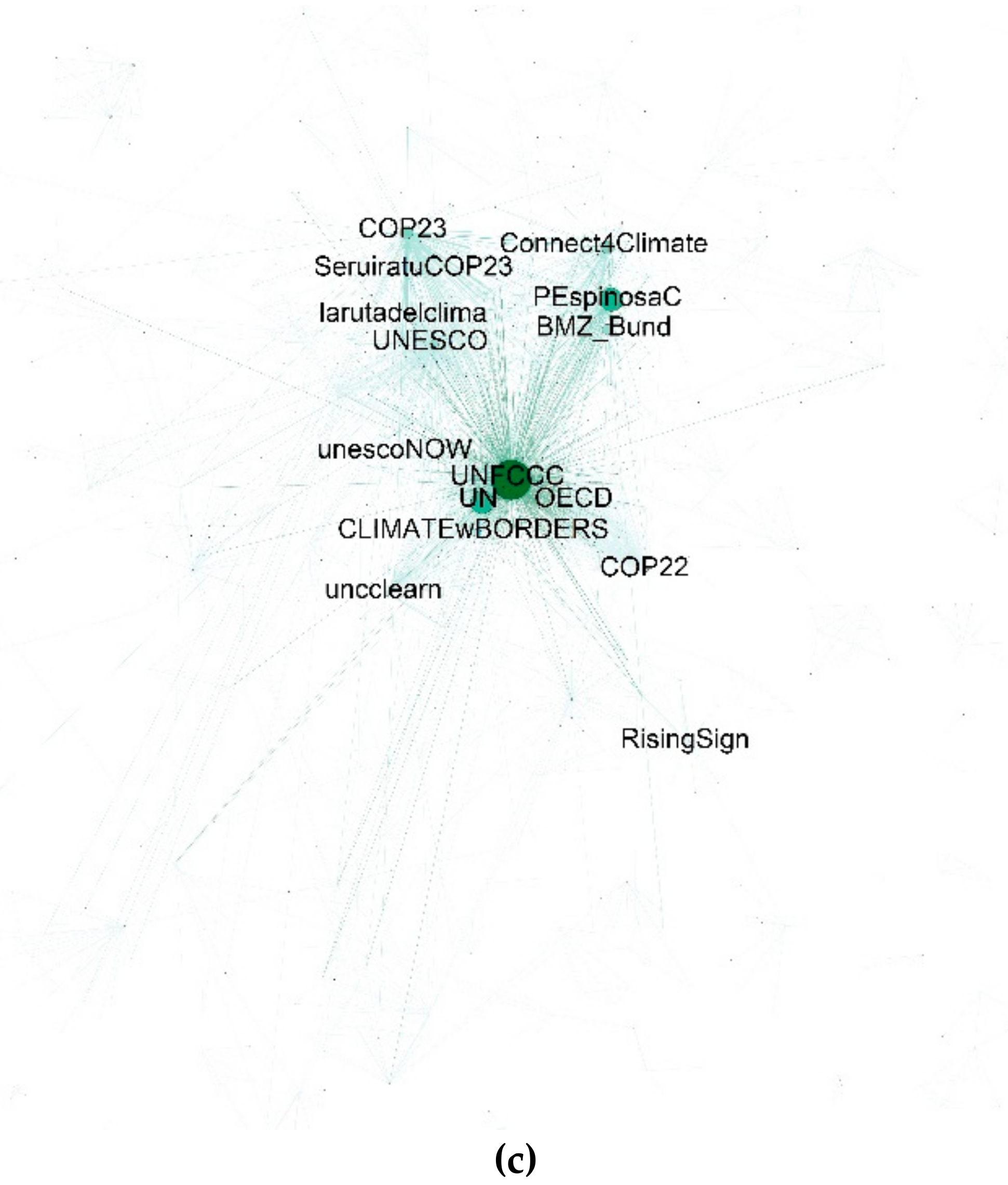Education for Sustainable Development and Climate Change Education: The Potential of Social Network Analysis Based on Twitter Data
Abstract
1. Introduction
2. The Concept of Education for Sustainable Development
3. Using a Network Perspective to Study ESD
4. Twitter Data as a Source for SNA
4.1. The Case for Twitter Data
4.2. Obtaining Twitter Data
4.3. From Data to Networks
education OR educators OR EduDay OR education day OR ClimateChangeEducation OR climateeducation OR climate education OR ESD OR education for sustainable development OR #SDG4 OR #ACEnow OR #GAPesd OR #ACE
4.4. Limitations of Twitter Data
5. Discussion and Conclusions
Author Contributions
Funding
Acknowledgments
Conflicts of Interest
References
- World Commission on Environment and Development. Our Common Future; Oxford University Press: Oxford, UK, 1987. [Google Scholar]
- Kolleck, N.; Jörgens, H.; Well, M. Levels of Governance in Policy Innovation Cycles in Community Education: The Cases of Education for Sustainable Development and Climate Change Education. Sustainability 2017, 9, 1966. [Google Scholar] [CrossRef]
- Michelsen, G.; Fischer, D. Sustainability and Education. In Sustainable Development Policy; Hauff, M., von Kuhnke, C., Eds.; Routledge: London, UK, 2017. [Google Scholar]
- Kolleck, N. Uncovering Influence through Social Network Analysis: The Role of Schools in Education for Sustainable Development. J. Educ. Policy 2016, 31, 308–329. [Google Scholar] [CrossRef]
- UNESCO. Not Just Hot Air. Putting Climate Change Education into Practice; UNESCO: Paris, France, 2015. [Google Scholar]
- Lecy, J.; Mergel, I.A.; Schmitz, H.P. Networks in Public Administration: Current Scholarship in Review. Public Manag. Rev. 2014, 16, 643–665. [Google Scholar] [CrossRef]
- Rode, H.; Michelsen, G. Der Beitrag der UN-Dekade 2005–2014 zu Verbreitung und Verankerung der Bildung für Nachhaltige Entwicklung; Deutsche UNESCO-Kommission eV (DUK): Bonn, Germany, 2012. [Google Scholar]
- United Nations Conference on Environment and Development. Agenda 21, Rio Declaration, Forest Principles; United Nations: New York, NY, USA, 1992; Available online: https://sustainabledevelopment.un.org/outcomedocuments/agenda21 (accessed on 3 October 2019).
- Springett, D. Education for Sustainable Development: Challenges of a Critical Pedagogy. In Routledge International Handbook of Sustainable Development; Redclift, M., Springett, D., Eds.; Routledge: London, UK, 2015. [Google Scholar]
- United Nations. General Assembly Resolution 57/254: United Nations Decade of Education for Sustainable Development. 2002. Available online: https://undocs.org/en/A/RES/57/254 (accessed on 3 October 2019).
- Lafferty, W.M.; Meadowcroft, J. Implementing Sustainable Development: Strategies and Initiatives in High Consumption Societies; Oxford University Press: Oxford, UK, 2000. [Google Scholar]
- UNESCO. Global Action Programme on Education for Sustainable Development. Available online: https://en.unesco.org/gap (accessed on 16 September 2019).
- Lafferty, W.M. Introduction: Form and Function in Governance of Sustainable Development. In Governance for Sustainable Development: The Challenge of Adapting Form to Function; Lafferty, W.M., Ed.; Edward Elgar Publishing: Cheltenham, UK, 2004. [Google Scholar]
- Huckle, J.; Sterling, S.R.; Sterling, S. Education for Sustainability; Earthscan: London, UK, 1996. [Google Scholar]
- Bonnett, M. Education for Sustainable Development: A Coherent Philosophy for Environmental Education? Camb. J. Educ. 1999, 29, 313–324. [Google Scholar] [CrossRef]
- De Haan, G. Gestaltungskompetenz als Kompetenzkonzept der Bildung für nachhaltige Entwicklung [Design Competence as a Competence Concept of Education for Sustainable Development]. In Kompetenzen der Bildung für nachhaltige Entwicklung: Operationalisierung, Messung, Rahmenbedingungen, Befunde [Competences of Education for Sustainable Development: Operationalization, Measurement, Framework Conditions, Findings]; Bormann, I., de Haan, G., Eds.; VS Verlag für Sozialwissenschaften: Wiesbaden, Germany, 2008. [Google Scholar]
- Stevenson, R.B. Tensions and Transitions in Policy Discourse: Recontextualizing a Decontextualized EE/ESD Debate. Environ. Educ. Res. 2006, 12, 277–290. [Google Scholar] [CrossRef]
- Vare, P.; Scott, W. Learning for a Change: Exploring the Relationship between Education and Sustainable Development. J. Edu. Sustain. Dev. 2007, 1, 191–198. [Google Scholar] [CrossRef]
- Wals, A.E.J.; Kieft, G. Education for Sustainable Development: Research Overview; Swedish International Development Cooperation Agency: Stockholm, Sweden, 2010. [Google Scholar]
- Tilbury, D. Environmental Education for Sustainability: Defining the New Focus of Environmental Education in the 1990s. Environ. Educ. Res. 1995, 1, 195–212. [Google Scholar] [CrossRef]
- Selby, D.; Kagawa, F. Archipelagos of learning: Environmental education on islands. Environ. Conserv. 2018, 45, 137–146. [Google Scholar] [CrossRef]
- Selby, D.; Kagawa, F. Teetering on the Brink. J. Transform. Educ. 2018, 16, 302–322. [Google Scholar] [CrossRef]
- González-Gaudiano, E. Education for Sustainable Development: Configuration and meaning. Policy Futures Educ. 2005, 3, 243–250. [Google Scholar] [CrossRef]
- Schneider, V. Netzwerke und Relationalismus: Netzwerkanalyse aus metatheoretischer Perspektive. In Knoten und Kanten III: Soziale Netzwerkanalyse in Geschichts- und Politikforschung; Gamper, M., Reschke, L., Düring, M., Eds.; Transcript-Verlag: Bielefeld, Germany, 2015. [Google Scholar]
- Borgatti, S.P.; Mehra, A.; Brass, D.J.; Labianca, G. Network Analysis in the Social Sciences. Science 2009, 323, 892–895. [Google Scholar] [CrossRef] [PubMed]
- Freeman, L.C. A Set of Measures of Centrality Based on Betweenness. Sociometry 1977, 40, 35. [Google Scholar] [CrossRef]
- Leontief, W. The Structure of American Economy, 1919–1929. An Empirical Application of Equilibrium Analysis; Harvard University Press: Cambridge, MA, USA, 1941. [Google Scholar]
- Seeley, J.R. The net of reciprocal influence; a problem in treating sociometric data. Can. J. Psychol. Can. Psychol. 1949, 3, 234–240. [Google Scholar] [CrossRef]
- Hoff, P.D.; Ward, M.D. Modeling Dependencies in International Relations Networks. Polit. Anal. 2004, 12, 160–175. [Google Scholar] [CrossRef]
- Cranmer, S.J.; Leifeld, P.; McClurg, S.D.; Rolfe, M. Navigating the Range of Statistical Tools for Inferential Network Analysis. Am. J. Polit. Sci. 2017, 61, 237–251. [Google Scholar] [CrossRef]
- Borgatti, S.P.; Everett, M.G.; Johnson, J.C. Analyzing Social Networks, 2nd ed.; Sage: Los Angeles, CA, USA, 2018. [Google Scholar]
- Snijders, T.A.; Van De Bunt, G.G.; Steglich, C.E. Introduction to stochastic actor-based models for network dynamics. Soc. Netw. 2010, 32, 44–60. [Google Scholar] [CrossRef]
- Cranmer, S.J.; Desmarais, B.A. Inferential Network Analysis with Exponential Random Graph Models. Polit. Anal. 2011, 19, 66–86. [Google Scholar] [CrossRef]
- Hanneke, S.; Fu, W.; Xing, E.P. Discrete temporal models of social networks. Electron. J. Stat. 2010, 4, 585–605. [Google Scholar] [CrossRef]
- Leifeld, P.; Cranmer, S.J. A theoretical and empirical comparison of the temporal exponential random graph model and the stochastic actor-oriented model. Netw. Sci. 2019, 7, 20–51. [Google Scholar] [CrossRef]
- Leifeld, P. Discourse Network Analysis: Policy Debates as Dynamic Networks. In The Oxford Handbook of Political Networks; Victor, J.N., Montgomery, A.H., Lubell, M., Eds.; Oxford University Press: Oxford, UK, 2017. [Google Scholar]
- eMarketer. eMarketer Updates Worldwide Social Network User Figures. 17 July 2017. Available online: https://www.emarketer.com/Article/eMarketer-Updates-Worldwide-Social-Network-User-Figures/1016178 (accessed on 25 July 2019).
- Twitter. The 2014 #YearOnTwitter. Available online: https://blog.twitter.com/official/en_us/a/2014/the-2014-yearontwitter.html (accessed on 25 July 2019).
- Twitter. Q1 2019 Earning Reports. Available online: https://s22.q4cdn.com/826641620/files/doc_financials/2019/q1/Q1-2019-Slide-Presentation.pdf (accessed on 25 July 2019).
- Ahmed, W. Using Twitter as a Data Source: An Overview of Social Media Research Tools (2019). Available online: https://blogs.lse.ac.uk/impactofsocialsciences/2019/06/18/using-twitter-as-a-data-source-an-overview-of-social-media-research-tools-2019/ (accessed on 25 July 2019).
- Costenbader, E.; Valente, T.W. The stability of centrality measures when networks are sampled. Soc. Netw. 2003, 25, 283–307. [Google Scholar] [CrossRef]
- Kossinets, G. Effects of missing data in social networks. Soc. Networks 2006, 28, 247–268. [Google Scholar] [CrossRef]
- Koskinen, J.; Snijders, T.A.B.; Lusher, D.; Robins, G. Simulation, Estimation and Goodness of Fit; Cambridge University Press: Cambridge, UK, 2013. [Google Scholar]
- Koskinen, J.H.; Robins, G.L.; Pattison, P.E. Analysing exponential random graph (p-star) models with missing data using Bayesian data augmentation. Stat. Methodol. 2010, 7, 366–384. [Google Scholar] [CrossRef]
- Conover, M.; Ratkiewicz, J.; Francisco, M.; Gonçalves, B.; Flammini, A.; Menczer, F. Political Polarization on Twitter. In Proceedings of the Fifth International AAAI Conference on Weblogs and Social Media, Barcelona, Spain, 17–21 July 2011. [Google Scholar]
- Dubois, E.; Gaffney, D. The Multiple Facets of Influence: Identifying Political Influentials and Opinion Leaders on Twitter. Am. Behav. Sci. 2014, 58, 1260–1277. [Google Scholar] [CrossRef]
- Williams, H.T.; McMurray, J.R.; Kurz, T.; Lambert, F.H. Network analysis reveals open forums and echo chambers in social media discussions of climate change. Glob. Environ. Chang. 2015, 32, 126–138. [Google Scholar] [CrossRef]
- Burson Cohn & Wolfe. Twiplomacy Study 2018. Available online: https://twiplomacy.com/blog/twiplomacy-study-2018/ (accessed on 18 July 2019).
- Steinert-Threlkeld, Z.C. Twitter as Data; Cambridge University Press: Cambridge, UK, 2018; ISBN 9781108438339. [Google Scholar]
- Morstatter, F.; Liu, H. Discovering, Assessing, and Mitigating Data Bias in Social Media. Online Soc. Netw. Media 2017, 1, 1–13. [Google Scholar] [CrossRef]
- Morstatter, F.; Pfeffer, J.; Liu, H.; Carley, K.M. Is the Sample Good Enough? Comparing Data from Twitter’s Streaming API with Twitter’s Firehose. In Proceedings of the Seventh international AAAI conference on weblogs and social media 2013, Cambridge, MA, USA, 28 June 2013. [Google Scholar]
- Alaimo, K. Twitter’s Misguided Barriers for Researchers, 16 Oct 2018. Bloomberg, 16 October 2018. Available online: https://www.bloomberg.com/opinion/articles/2018-10-16/twitter-s-barriers-for-academic-researchers-are-misguided (accessed on 18 July 2019).
- Twitter. UNESCO Account. Available online: https://twitter.com/UNESCO (accessed on 25 July 2019).
- Kolleck, N.; Well, M.; Sperzel, S.; Jörgens, H. The Power of Social Networks: How the UNFCCC Secretariat Creates Momentum for Climate Education. Glob. Environ. Polit. 2017, 94, 106–126. [Google Scholar] [CrossRef]
- Goritz, A.; Kolleck, N.; Jörgens, H. Analyzing Twitter Data: Advantages and Challenges in the Study of UN Climate Negotiations. SAGE Res. Meth. Case. 2019. [Google Scholar] [CrossRef]
- Schuster, J.; Jörgens, H.; Kolleck, N. Using Social Network Analysis to Study Twitter Data in the Field of International Agreements. SAGE Res. Meth. Case. 2019. [Google Scholar] [CrossRef]
- Twitter. Twitter account of UNESCO EU. Available online: https://twitter.com/UNESCOEU/status/1069591595895480321 (accessed on 18 July 2018).
- United Nations. United Nations Framework Convention on Climate Change; FCCC/INFORMAL/84; United Nations: New York, NY, USA, 1992. [Google Scholar]
- UNFCCC. Paris Agreement; UNFCCC: Paris, France, 2015; Available online: https://unfccc.int/sites/default/files/english_paris_agreement.pdf (accessed on 25 July 2019).
- Sifter. Available online: https://sifter.texifter.com/ (accessed on 12 August 2019).
- Page, L.; Brin, S.; Motwani, R.; Winograd, T. The PageRank Citation Ranking: Bringing Order to the Web. 1999. Available online: http://ilpubs.stanford.edu:8090/422/ (accessed on 3 October 2019).
- Perez, B.; Musolesi, M.; Stringhini, G. You Are Your Metadata: Identification and Obfuscation of Social Media Users Using Metadata Information. In Proceedings of the 12th International AAAI Conference on Web and Social Media (ICWSM 2018) 2018, Stanford, CA, USA, 25–28 June 2018. [Google Scholar]




| COP21 | COP22 | COP23 | |
|---|---|---|---|
| 1. | UNFCCC | UN | UNFCCC |
| 2. | UNESCO | UNFCCC | PEspinosaC |
| 3. | UNICEF | UNESCO | UN |
| 4. | najatvb | BofA_News | Connect4Climate |
| 5. | COP21en | GBLFoundation | COP23 |
| 6. | haliscolb | GEMReport | BMZ_Bund |
| 7. | IrinaBokova | HuffPostGreen | UNESCO |
| 8. | RoyalSegolene | COP22 | CLIMATEwBORDERS |
| 9. | UNICEFtalk | ManosAntoninis | uncclearn |
| 10. | COP21 | IrinaBokova | larutadelclima |
| 11. | UNITAR | Education2030UN | SeruiratuCOP23 |
| 12. | UNEP | PEspinosaC | COP22 |
| 13. | UNwomen | UNEP | RisingSign |
| 14. | earthguardianz | Abibimman | unescoNOW |
| 15. | unicefniger | ClimateCoLab | OECD |
© 2019 by the authors. Licensee MDPI, Basel, Switzerland. This article is an open access article distributed under the terms and conditions of the Creative Commons Attribution (CC BY) license (http://creativecommons.org/licenses/by/4.0/).
Share and Cite
Goritz, A.; Kolleck, N.; Jörgens, H. Education for Sustainable Development and Climate Change Education: The Potential of Social Network Analysis Based on Twitter Data. Sustainability 2019, 11, 5499. https://doi.org/10.3390/su11195499
Goritz A, Kolleck N, Jörgens H. Education for Sustainable Development and Climate Change Education: The Potential of Social Network Analysis Based on Twitter Data. Sustainability. 2019; 11(19):5499. https://doi.org/10.3390/su11195499
Chicago/Turabian StyleGoritz, Alexandra, Nina Kolleck, and Helge Jörgens. 2019. "Education for Sustainable Development and Climate Change Education: The Potential of Social Network Analysis Based on Twitter Data" Sustainability 11, no. 19: 5499. https://doi.org/10.3390/su11195499
APA StyleGoritz, A., Kolleck, N., & Jörgens, H. (2019). Education for Sustainable Development and Climate Change Education: The Potential of Social Network Analysis Based on Twitter Data. Sustainability, 11(19), 5499. https://doi.org/10.3390/su11195499






